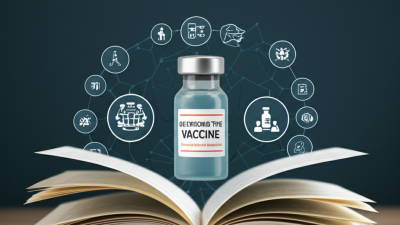The Vaccine Development Process has undergone significant transformations in recent years, driven by technological advancements and urgent global health needs. According to a report by Grand View Research, the global vaccine market is projected to reach USD 109.9 billion by 2025, emphasizing the increased investment and innovation in this field. With the vaccine development cycle traditionally spanning several years, the recent expedited timelines seen during the COVID-19 pandemic have challenged conventional methodologies and showcased the necessity for optimization.

Furthermore, a study published by the Journal of Vaccines & Vaccination highlights that streamlined processes could reduce the development time by up to 75%, drastically improving responsiveness to emerging health threats. This guide will delve into effective strategies, digital tools, and actionable tips to enhance the Vaccine Development Process, ensuring not only a quicker turnaround but also a more robust defense against future pandemics.
Alternative approaches in vaccine development have gained significant attention in recent years as researchers look for innovative ways to expedite the process while ensuring safety and efficacy. Traditional methods, while effective, often involve lengthy timelines and complex procedures. By incorporating alternative strategies such as mRNA technology, viral vector platforms, and innovative adjuvants, scientists can potentially reduce development times and improve the robustness of vaccine responses. Embracing these novel methodologies allows for a more flexible and responsive approach to public health needs, particularly in the face of emerging infectious diseases.
Moreover, the importance of collaboration and interdisciplinary research cannot be overstated when exploring alternative vaccine approaches. By harnessing the expertise of various scientific fields—such as genomics, immunology, and data science—researchers can enhance the platform technologies that underpin vaccine development. This collaborative spirit not only drives innovation but also fosters a more dynamic environment for discovering solutions that can address global health challenges more effectively. In this way, understanding and implementing alternative approaches is not merely an option; it is essential for the future of vaccine development and success in safeguarding public health.
In the quest for rapid vaccine development, evaluating various vaccine platforms has become critical. Recent data from the World Health Organization (WHO) indicate that mRNA technology has revolutionized the response speed to infectious diseases. For instance, the Pfizer-BioNTech and Moderna vaccines were developed within a record time of less than a year, demonstrating the platform's capacity for rapid adaptation to emerging pathogens. This is particularly significant in light of the 2019 Global Vaccine Market Report, which projects the mRNA vaccine market to reach $58 billion by 2026, underscoring its potential for future vaccine candidates.
In addition to mRNA, viral vector platforms such as those utilized by AstraZeneca and Johnson & Johnson have also shown promise, particularly in terms of stability and broad immunogenicity. A 2021 study published in *Nature* illustrated that viral vector vaccines could induce robust T-cell responses, essential for longer-term immunity. However, the development timelines for these platforms can be longer compared to mRNA vaccines due to manufacturing challenges and regulatory hurdles. As the vaccine landscape continues to evolve, understanding the strengths and weaknesses of these different platforms will be crucial in optimizing the vaccine development process for future public health emergencies.
The integration of advanced technologies into the traditional vaccine development process is paving the way for groundbreaking improvements in efficiency and effectiveness. By leveraging cutting-edge tools, such as artificial intelligence and machine learning, researchers can significantly accelerate the identification of potential vaccine candidates. These technologies enable the analysis of vast amounts of data, allowing scientists to predict how different antigens might behave in the human immune system, thus streamlining the pre-clinical phase of vaccine development.
Moreover, the adoption of methodologies like mRNA technology exemplifies how innovation can enhance traditional practices. This approach not only shortens the time needed for vaccine production but also allows for rapid adaptability in response to emerging pathogens. Coupled with advanced bioprocessing techniques and real-time monitoring systems, these technologies facilitate a more agile production environment, ensuring that vaccines can be developed, tested, and deployed with unprecedented speed. By harnessing these advanced technologies, the vaccine development process can transform, ultimately leading to more effective public health responses and better preparedness for future outbreaks.
| Technology | Description | Benefits | Challenges | Future Potential |
|---|---|---|---|---|
| mRNA Technology | Uses messenger RNA to instruct cells to produce antigens. | Rapid development, flexible design, effectiveness against emerging viruses. | Storage requirements, public perception and acceptance. | Broad application potential in various infectious diseases. |
| Viral Vector Vaccines | Uses an altered virus to deliver genetic material into cells. | Strong immune response and potential for single-dose vaccines. | Pre-existing immunity to vector viruses, manufacturing challenges. | Promising for tumor therapy and infectious diseases. |
| Protein Subunit Vaccines | Contains harmless pieces of the target pathogen (proteins). | Safer and well-established, good for allergic individuals. | May require adjuvants to enhance immune response. | Effective in developing vaccines for a range of pathogens. |
| Nanotechnology | Utilizes nanomaterials for vaccine delivery and immune modulation. | Improved targeting, sustained release, enhanced uptake. | Regulatory hurdles, production scalability. | Could revolutionize vaccine formulations and personalized medicine. |
| Bioinformatics | Uses computational tools for vaccine design and development strategies. | Accelerates identification of targets and optimizes formulations. | Requires significant data and computational resources. | Can enhance predictive modeling and reduce development times. |
As the global demand for vaccines continues to grow, exploring alternative vaccine solutions has become imperative. Assessing regulatory pathways for these alternatives can unlock faster routes to market while ensuring safety and efficacy. Regulatory frameworks must adapt to innovations like mRNA technology, viral vectors, and protein subunit vaccines. Understanding these pathways allows developers to navigate complex approval processes effectively, minimizing delays and optimizing resources.
Collaboration with regulatory agencies is essential in this dynamic environment. Early engagement can provide clarity on requirements and potential challenges. Tailored guidance may lead to expedited reviews or even special designations, such as Fast Track or Breakthrough Therapy, which are designed to accommodate the unique aspects of alternative vaccine candidates. By strategically aligning with regulatory expectations, developers can enhance their chances of success in delivering novel vaccine solutions to the public, addressing urgent health needs in a timely manner.
The landscape of vaccine development has undergone significant transformation, primarily through collaborative strategies that leverage public and private partnerships. According to a report by the Coalition for Epidemic Preparedness Innovations (CEPI), nearly 50% of vaccine candidates currently in clinical trials have emerged from collaborations between pharmaceutical companies and public health organizations. This synergy has proven essential in accelerating the development timeline while also sharing risks and resources. For instance, during the COVID-19 pandemic, the Operation Warp Speed initiative in the U.S. demonstrated how federal funding could catalyze rapid innovation, allowing companies like Moderna to go from concept to emergency use authorization in less than a year.
Further emphasizing the impact of these partnerships, an analysis from the World Health Organization (WHO) outlines that vaccine development costs can reach upward of $1 billion per vaccine, a daunting barrier for many organizations. However, partnerships can mitigate these financial burdens, enabling sharing of expertise and logistical infrastructure. The Global Vaccine Alliance (GAVI) has also played a crucial role by pooling resources and fostering partnerships, which have resulted in the successful rollout of vaccines in low-income countries. Such collaborations highlight the critical role that public-private alliances play in not only innovating vaccine solutions but also ensuring equitable access in the global market.
